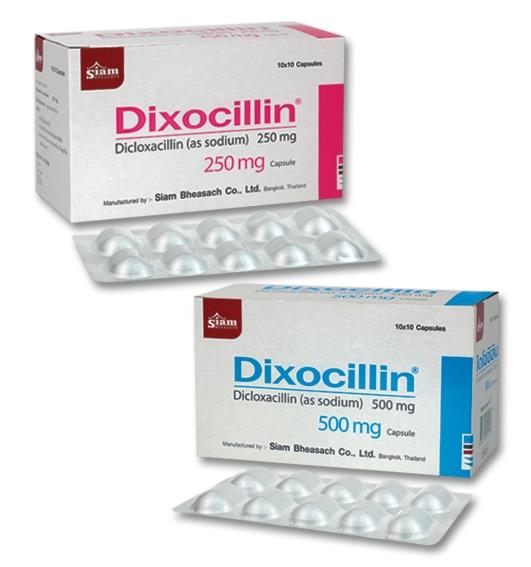Dicloxacillin: Uses, Mechanism, and Clinical Importance

Introduction
Dicloxacillin is a narrow-spectrum beta-lactam antibiotic that belongs to the class of penicillinase-resistant penicillins. It is used primarily to treat infections caused by Gram-positive bacteria, especially penicillinase-producing staphylococci. As antibiotic resistance becomes a growing concern, medications like dicloxacillin serve a targeted role in combating specific bacterial infections without contributing broadly to resistance across microbial populations. This essay explores dicloxacillin in depth, discussing its uses, pharmacology, benefits, side effects, and clinical significance.
What is Dicloxacillin?
Dicloxacillin is a semi-synthetic penicillin antibiotic, designed to resist degradation by penicillinase (beta-lactamase)—an enzyme secreted by some bacteria that inactivates many penicillins. It is chemically similar to other penicillins but has a modified structure that makes it effective against Staphylococcus aureus, including strains that produce penicillinase (but not MRSA—methicillin-resistant S. aureus).
Dicloxacillin is available in oral form, typically as capsules or liquid suspension. It is well-absorbed from the gastrointestinal tract and is known for its good bioavailability when taken on an empty stomach.
Primary Uses of Dicloxacillin
Dicloxacillin is mainly used to treat mild to moderately severe infections caused by penicillinase-producing staphylococci. These include:https://todayliv.com/what-are-the-benefits-of-pharmaceuticals/
- Skin and Soft Tissue Infections
Impetigo
Cellulitis
Abscesses
Boils and furuncles
Infected wounds or insect bites
Skin infections are among the most common uses of dicloxacillin, especially those involving S. aureus. It is particularly useful in community-acquired settings where methicillin-sensitive strains (MSSA) are prevalent.
- Bone and Joint Infections
Osteomyelitis (bone infection)
Septic arthritis (infected joints)
Dicloxacillin is often part of long-term treatment regimens for infections involving bones or joints, though usually given initially in intravenous forms and later followed by oral dicloxacillin for maintenance therapy.
- Respiratory Tract Infections
Pharyngitis (when caused by susceptible strains)
Pneumonia (particularly when S. aureus is suspected)
Sinusitis and bronchitis (less commonly)
In respiratory tract infections, dicloxacillin is not a first-line treatment unless there is a confirmed or suspected staphylococcal cause.
- Urinary Tract Infections (UTIs)
Although not commonly used for UTIs, dicloxacillin may be prescribed if S. aureus is isolated from urine cultures, especially in catheter-associated or hospital-acquired infections.
- Mastitis
In breastfeeding women with staphylococcal mastitis (breast infection), dicloxacillin is often used due to its efficacy and safety profile.https://todayliv.com/what-are-the-benefits-of-pharmaceuticals/
How Dicloxacillin Works: Mechanism of Action
Dicloxacillin, like other beta-lactam antibiotics, exerts its bactericidal effect by inhibiting bacterial cell wall synthesis. It does this by binding to penicillin-binding proteins (PBPs) inside the bacterial cell wall. These proteins are involved in the final stages of cell wall construction. When dicloxacillin binds to them, it prevents cross-linking of the peptidoglycan layer, weakening the cell wall and ultimately causing bacterial lysis and death.
What sets dicloxacillin apart is its resistance to beta-lactamase enzymes, which are produced by many resistant staphylococci to inactivate standard penicillins. Dicloxacillin’s side chain structure protects it from enzymatic destruction, making it particularly effective against penicillinase-producing strains.
Dosage and Administration
Dicloxacillin is usually taken orally 4 times a day (every 6 hours) on an empty stomach, ideally 1 hour before or 2 hours after meals. This enhances absorption and ensures optimal blood levels.
Typical adult dosages:
Mild infections: 125–250 mg four times a day
Moderate to severe infections: 500 mg four times a day
In pediatric populations, dosage is based on weight and severity of infection.
Advantages and Benefits
Beta-lactamase resistance: Effective where regular penicillins fail.
Targeted therapy: Reduces impact on normal flora compared to broad-spectrum antibiotics.
Well-tolerated: Fewer side effects than many other antibiotic classes.
Oral availability: Convenient for outpatient treatment.
Cost-effective: Generally affordable and widely available.https://todayliv.com/what-are-the-benefits-of-pharmaceuticals/
Side Effects and Risks
Although dicloxacillin is generally well-tolerated, it can cause adverse reactions, including:
Common Side Effects:
Nausea
Vomiting
Diarrhea
Abdominal pain
Less Common or Serious Side Effects:
Allergic reactions (rash, hives, anaphylaxis in severe cases)
Liver dysfunction (elevated liver enzymes or cholestatic jaundice)
Clostridium difficile–associated diarrhea
Blood dyscrasias (rare)
Patients with a penicillin allergy should avoid dicloxacillin, as cross-reactivity is possible.
Contraindications and Precautions
Allergy to penicillins: A known allergy is an absolute contraindication.
Pregnancy and breastfeeding: Generally considered safe but should be used under medical supervision.
Liver disease: Should be used cautiously in patients with hepatic impairment.
Drug interactions: Dicloxacillin may reduce the effectiveness of oral contraceptives and can interact with drugs like methotrexate or warfarin.https://todayliv.com/what-are-the-benefits-of-pharmaceuticals/
Antibiotic Resistance and Dicloxacillin
While dicloxacillin is effective against penicillinase-producing S. aureus, it is ineffective against MRSA, which has altered PBPs that prevent dicloxacillin binding. As a result, culture and sensitivity testing are crucial when treating serious infections.
The judicious use of dicloxacillin helps prevent the development of resistance. It should not be used for infections caused by Gram-negative organisms or anaerobes, where it lacks efficacy.
Comparisons with Similar Drugs
Nafcillin: Intravenous version with similar spectrum; used for more severe infections.
Oxacillin: Similar to nafcillin but with slightly different pharmacokinetics.
Amoxicillin-clavulanate: Broader spectrum but more side effects; not penicillinase-resistant on its own.
Cephalexin: Another oral agent used for skin infections, but with a slightly broader range.
Dicloxacillin is preferred when the infecting organism is a known penicillinase-producing staph that is not methicillin-resistant, and when oral therapy is feasible.https://todayliv.com/what-are-the-benefits-of-pharmaceuticals/
Conclusion
Dicloxacillin remains a valuable tool in the treatment of infections caused by penicillinase-producing Staphylococcus aureus, especially in outpatient settings. Its oral availability, targeted action, and resistance to beta-lactamase make it especially useful in skin, soft tissue, and bone infections. While it is not a broad-spectrum antibiotic and is ineffective against MRSA and many Gram-negative bacteria, its focused action helps reduce unnecessary disruption of the body’s normal flora and lowers the risk of widespread antibiotic resistance.
Like all antibiotics, dicloxacillin should be used responsibly, guided by culture results when possible, and tailored to the patient’s clinical condition. When used appropriately, it is a safe, effective, and practical option in the fight against bacterial infections.